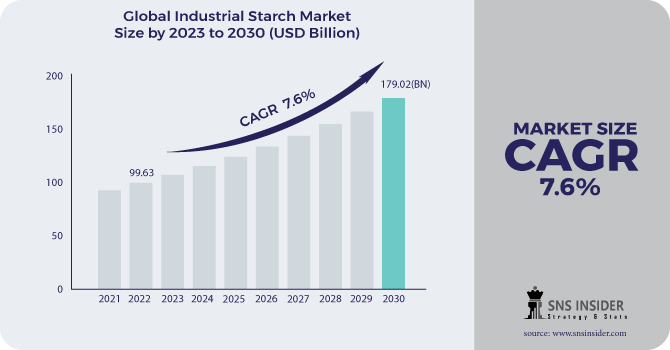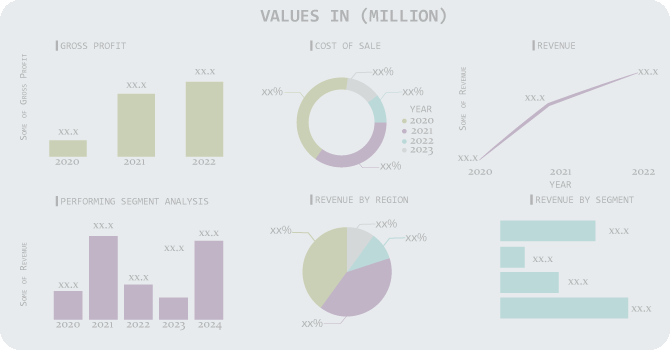Industrial Starch Market Report Scope & Overview:
The Industrial Starch Market size was esteemed at USD 99.63 billion out of 2022 and is supposed to arrive at USD 179.02 billion by 2030, and develop at a CAGR of 7.6% over the forecast period 2023-2030.
Starch is a sugar separated from horticultural unrefined components, which tracks down applications in a large number of regular food and non-food items. Modern starches are gotten from different sources, including corn, potato, wheat, and different sources. With the worldwide economy steadily improving and bringing about an expanded admission of handled and comfort food varieties, the market for modern starch, which tracks down significant utilization in these food applications, is tracking down the expanded request, in this manner driving the general market.

The interest in changed starches is expanding in a line up with the fast improvement of the food business. Changed starches offer a colossal number of useful advantages to different food varieties, like bread shops, bites, drinks, and wholesome food sources.
Endlessly starch subordinates have different useful qualities including thickeners, stabilizers, estimating, fat replacers, and restricting in different food and non-food applications. What's more, starch subsidiaries are utilized as a powerful aging base for the mass creation of different biotechnological items like natural acids, anti-infection agents, nutrients, and chemicals. Albeit the food business is projected to be the biggest end client of starch and its subsidiaries, it is likewise progressively utilized in different opposite end-use applications, like paper, building materials, beauty care products, and drugs. Likewise, local starch is helpful in a large number of utilizations.
Market Dynamics:
Driving Factors:
-
Rising interest for starch in non-food applications like tidbits, pastry shops, drinks, and utilitarian food varieties.
-
Expanded utilization of starch in biodegradable plastic and food items and added substances.
Restraining Factors:
-
Upgrades in the creation cycle and the advancement of wastewater treatment advances.
-
The significant expense of the examination.
Opportunities:
- Improvement exercises and the ascent of the gum arabic market.
Challenges:
-
Prerequisite of consistency in the development of unrefined components.
Impact of COVID-19:
The COVID-19 pandemic put uncommon weights on food supply chains, with bottlenecks in ranch work, handling, transport, and coordinated factors, as well as earth-shattering changes popular. The impact on the agrarian areas, including corn, potato, custard, and wheat, trailed by its middle of the road item, like starches, is minimal, attributable to the help of the public authority that guaranteed that the store network capability easily despite the emergency by settling the food frameworks, in this way supporting both food security and nourishment.
Market Estimation:
By source:
Corn starch is a carb separated from the endosperm of corn seeds. Corn starch is without gluten and subsequently is building up forward momentum on the lookout. It is a decent wellspring of energy and forestalls low glucose in people with nighttime hypoglycemia. Wheat starch is broadly utilized in the paper business as cement for surface covering and the creation of ridged sheets. It is likewise utilized in cotton getting done and clothing estimating, where it helps with offering an amazing completion. Cassava starch is utilized as a water-restricting and texturizing specialist and assists with accomplishing the wanted thickness in food items. Potato starch is without gluten and along these lines generally utilized as a choice of flour in pastry kitchen items. This can be credited to a rising number of wellbeing cognizant buyers having a more noteworthy inclination for sans gluten, synthetic-free, and added substance-free items.
By Product:
Native starches are the first type of starch. These are generally utilized in details of food sources, drugs, and other modern items. The properties of the local starch can be altered to suit different applications by corrosive and other substance medicines at determined temperatures. Cationic starch has been utilized in the paper business. The ability of the cationic starch to bond the cellulose filaments together outcomes in expanding the inner strength of the paper. Ethylated starch, corrosive altered starch, and oxidized starch are generally utilized in size press, tub, and schedules to further develop sheet strength, firmness, and surface attributes.
By Application:
The rising use of modern starch in the bread shop and candy store area is supposed to emphatically affect market development over the figure period. Growing interest for hurry food items and different drinks from the youthful and working populace is supposed to drive the section. Modern starches are utilized in creature feed, hydroponics feed, and pet food items by virtue of their limiting and balancing out properties. Functionalities of starch like biodegradability, biocompatibility, and gel-shaping capacity have brought about its expanded applications in the drug business. Modern starches are utilized in different end-use applications like paper and sheets, materials, natural synthetic compounds, catalysts, plastics, and pastes.
Market Segmentation:
By Source:
-
Corn
-
Wheat
-
Cassava
-
Potato
-
Others
By Product:
-
Native Starch and Starch Derivatives & Sweeteners
-
Cationic Starch
-
Ethylated Starch
-
Oxidized Starch
-
Acid Modified Starch
-
Unmodified Starch
By Application:
-
Food & Beverage
-
Bakery & Confectionery
-
Dairy & Frozen Desserts
-
Beverages
-
Convenience Foods
-
Others
-
-
Feed
-
Pharmaceuticals
-
Others
.png)
Regional Analysis:
-
North America
-
USA
-
Canada
-
Mexico
-
-
Europe
-
Germany
-
UK
-
France
-
Italy
-
Spain
-
The Netherlands
-
Rest of Europe
-
-
Asia-Pacific
-
Japan
-
south Korea
-
China
-
India
-
Australia
-
Rest of Asia-Pacific
-
-
The Middle East & Africa
-
Israel
-
UAE
-
South Africa
-
Rest of Middle East & Africa
-
-
Latin America
-
Brazil
-
Argentina
-
North America overwhelms the modern starch market and will keep on thriving in its pattern of predominance during the conjecture time frame attributable to the presence of significant vital participants and the positive effect of industrialization on the region's progression. Asia-Pacific is supposed to score the most elevated CAGR because of the developing usage of starch in different applications.
Key Players:
Cargill, Incorporated, Archer Daniels Midland Company, Ingredion Incorporated, Tate & Lyle PLC, AGRANA Beteiligungs-AG, Grain Processing Corporation, Roquette Frères, Tereos Group, Royal Cosun.
Cargill-Company Financial Analysis

| Report Attributes | Details |
|---|---|
| Market Size in 2022 | US$ 99.63 Billion |
| Market Size by 2030 | US$ 179.02 Billion |
| CAGR | CAGR 7.6% From 2023 to 2030 |
| Base Year | 2022 |
| Forecast Period | 2023-2030 |
| Historical Data | 2020-2021 |
| Report Scope & Coverage | Market Size, Segments Analysis, Competitive Landscape, Regional Analysis, DROC & SWOT Analysis, Forecast Outlook |
| Key Segments | • by Source (Corn, Wheat, Cassava, Potato) • by Product (Native, Cationic, Ethylated, Acid Modified, Unmodified) • by Application (Food & Beverage, Feed, Pharmaceuticals, and Others) |
| Regional Analysis/Coverage | North America (USA, Canada, Mexico), Europe (Germany, UK, France, Italy, Spain, Netherlands, Rest of Europe), Asia-Pacific (Japan, South Korea, China, India, Australia, Rest of Asia-Pacific), The Middle East & Africa (Israel, +D11UAE, South Africa, Rest of Middle East & Africa), Latin America (Brazil, Argentina, Rest of Latin America) |
| Company Profiles | Cargill, Incorporated, Archer Daniels Midland Company, Ingredion Incorporated, Tate & Lyle PLC, AGRANA Beteiligungs-AG, Grain Processing Corporation, Roquette Frères, Tereos Group, Royal Cosun. |
| Drivers | • Rising interest for starch in non-food applications like tidbits, pastry shops, drinks, and utilitarian food varieties. •Expanded utilization of starch in biodegradable plastic and food items and added substances. |
| Market Challenges | •Prerequisite of consistency in the development of unrefined components. |

